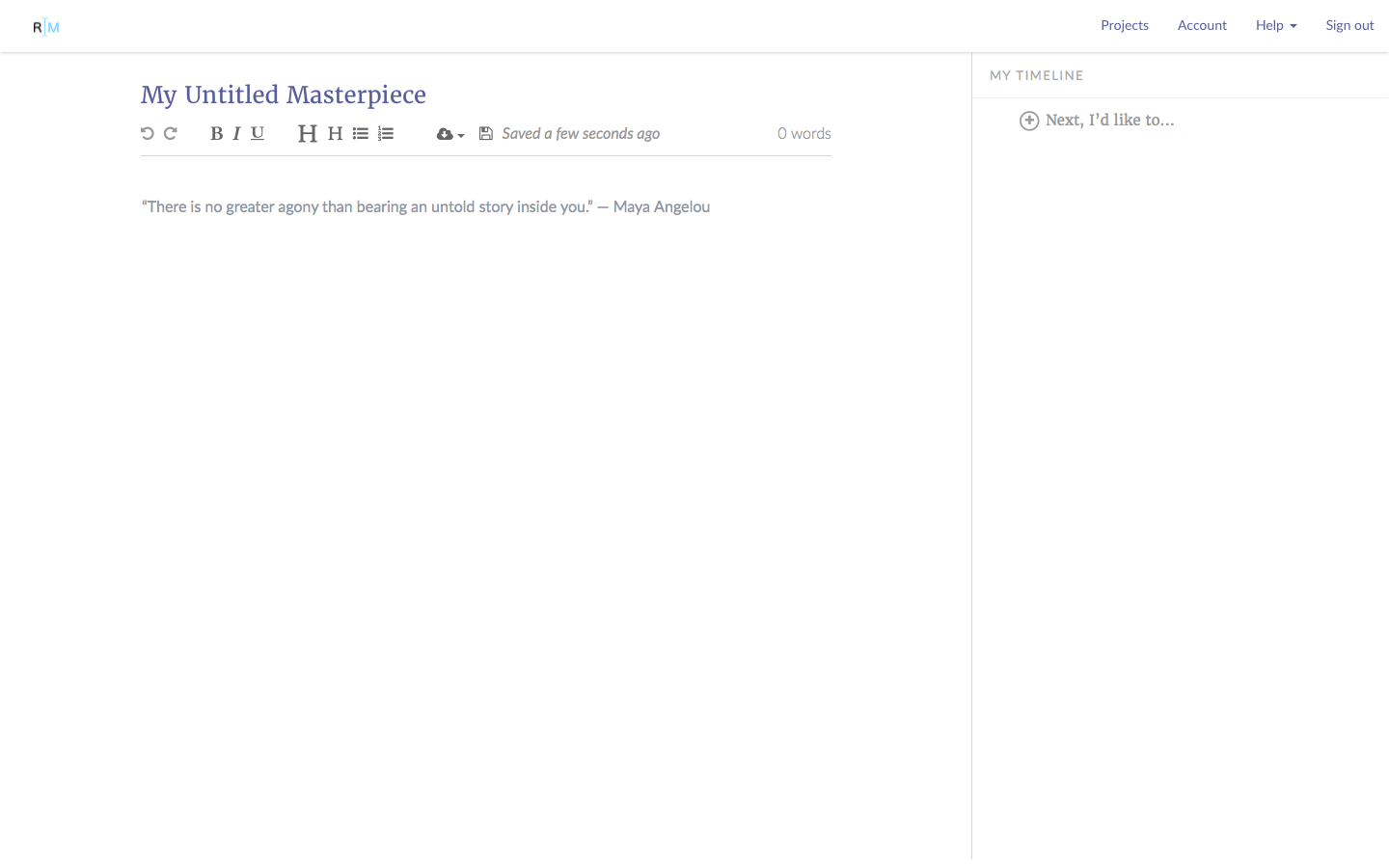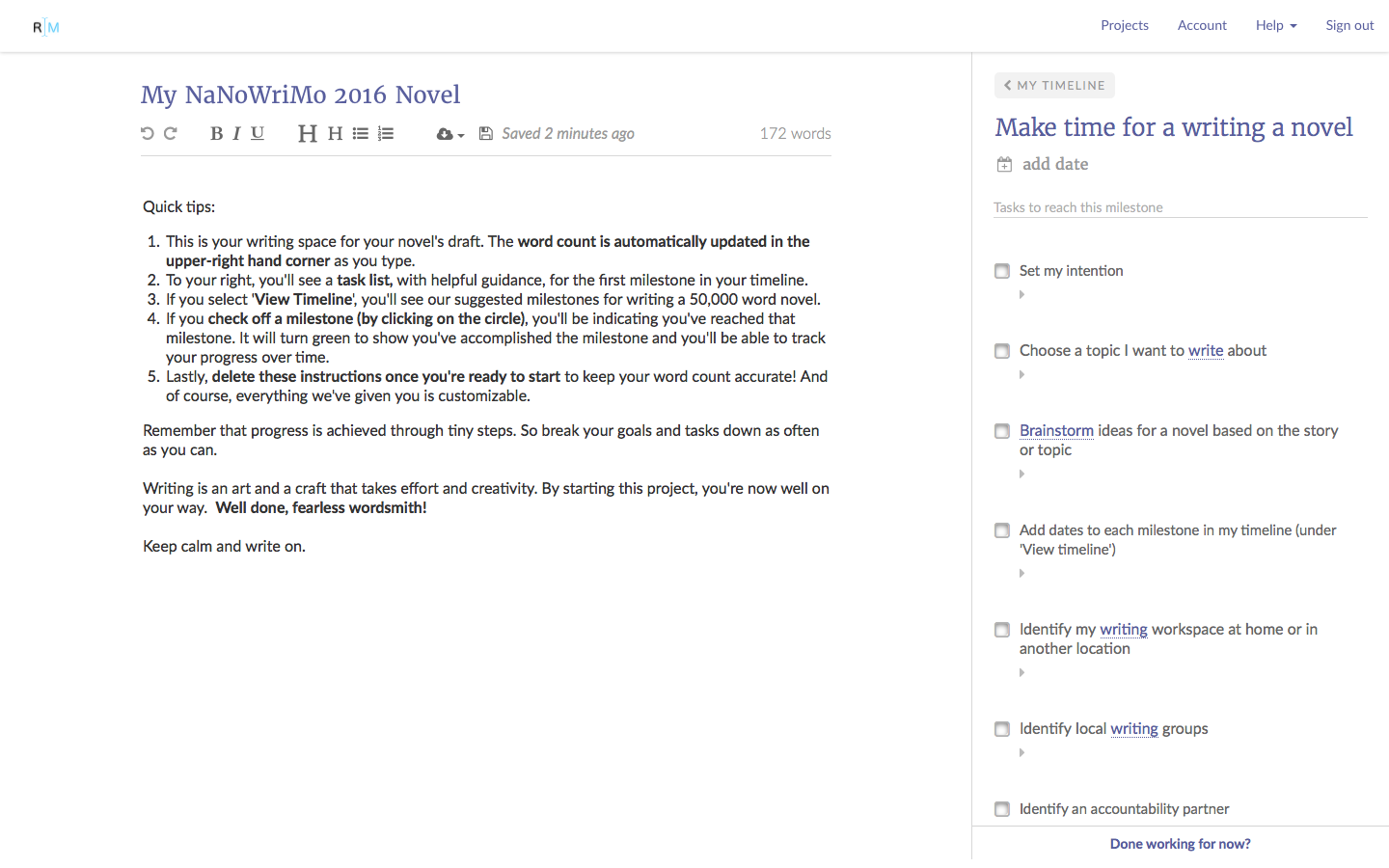
Case Study:
30-day Novel Challenge
Overview
Convince writers to start and finish new 50,000-word novels in 30 days using new online writing software.
Skills Used
- user flows
- product metrics
- visual design
Problem Definition
Every November, hundreds of thousands of writers around the world attempt to write 50,000 words of a new novel by Nov. 30 as part of National Novel Writing Month (NaNoWriMo). Reaching the 50k word count is winning NaNoWriMo. We wanted to entice 2016 NaNoWriMo participants to start (and ideally write) a new 50,000-word novel in 30 days using our online writing software at TheRightMargin.
Hypothesis
Creating a template of NaNoWriMo best practices, putting those best practices into our software, and giving the template away to NaNoWriMo participants via extended trials (through Nov. 30), would lead to more NaNoWriMo winners and customers for TheRightMargin.
Assumptions
- Our inbound marketing can generate enough traffic without expensive NaNoWriMo sponsorship.
- Our writing software features present unique value for novel writers to reimagine their 50,000-word goal as a series of actionable milestones and tasks.
- An extended trial will help new users win NaNoWriMo and convert to customers.
Success Metrics
- 250 sign ups via a custom landing page
- Increased average time on site (> 5 minutes) and retention
- 10% of trials to convert to customers
Audience & Personas
In November 2015, 431,626 writers attempted to write 50,000 words to win NaNoWriMo. ~11.5% reached their goal.
In our initial discussion with past NaNoWriMo participants, we learned that many were inundated with resources before and during NaNoWriMo. Those that had prepared before November found themselves in a much better position to make progress during November, even if they didn't win. There was no consistently in tools used, though most people wrote digitally to keep track of their daily and overall word count.
Our writing software at TheRightMargin helps writers break lofty goals (e.g. write a novel) into actionable milestones and tasks, with optional dates and encouragement. We felt like our approach could drastically help NaNoWriMo participants.
We found two NaNoWriMo personas: plotters and pantsers. Plotters prepared before November with research, outlines, and generally making room in their schedules and life for NaNoWriMo. Pantsers may have freed up more time for writing but did not do any preparatory work on their novels before November. We targeted plotters before November, because it afforded more time to market and they already seemed more aligned with TheRightMargin's product philosophy.
Team
As Senior UX Engineer, I worked:
- with our Founder and our UX designer to collect and synthesize NaNoWriMo best practices
- with our head of marketing to create and iterate on a NaNoWriMo landing page and product language
- to design and implement all product updates
Constraints
Our biggest constraint was time. We wanted to launch both a landing page, new sign up process, and the ability to benefit from NaNoWriMo best practices in-product within 4 weeks. That would give us 2 months to collect sign ups, iterate, and enter November.
Design Process
We conducted initial research by tapping into the local writing community, past NaNoWriMo participants via nanowrimo.org forums, meetups, and personal networks, and my personal experience doing similar challenges such as the 3-day Novel Contest. From our initial discussions, we quickly gathered that the plotter persona gave themselves a much higher chance of winning (writing 50,000 words by Nov. 30) by preparing before Nov 1.
Advice formation
Interviews with past participants, retrospective blog posts, and the nanowrimo.org were our best sources of advice on how to excel at NaNoWriMo. We arranged our takeaways in chronological writing milestones, full of actionable writing tasks, each with prompts to assist the completion of said task. They took the form of this hierarchy:
Project: My NaNoWriMo novel
- Milestone: Make time for a productive November (October 15)
* Task: Set my intention
Prompt: intention (n.) — why am I participating in NaNoWriMo?
Refer to this throughout November to keep yourself motivated.
* Task: Identify my writing workspace at home or in another location
Prompt: Where have I done my best writing?
* Task: ...
Prompt: ...
- Milestone: Plan my way to a novel-length idea (October 21)
* Task: What is central dramatic question my novel will answer?
Prompt: ...
* Task: Based on my central question, write a one sentence summary of my novel
Prompt: ...
* Task: ...
Prompt: ...
- Milestone: ...
* Task: ...
Prompt: ...
- Milestone: 1,667 words written (November 1)
* Task: ...
Prompt: ...
Landing page
The landing page I designed (live as of April 2017) spoke to preparation being the key to winning, in line with our plotter persona.

From zero-data view to actionable steps
We learned that once November started, no one would be seeking new advice so anything we offered had to be baked into the product. So rather than giving NaNoWriMo sign ups an catch-all onboarding experience or a zero-data view applicable to any writing project…

…we incorporated the best practices we learned into a writing project tailored to NaNoWriMo:

Because of the new sign up flow, I advocated and implemented tracking NaNoWriMo participants as a new user cohort, so we could compare and contrast their performance and metrics to existing and future users.
Results & Retrospective
-
Goal:
250 sign ups via a custom landing pageOutcome:
271 sign ups at a 27% conversion from visitor to trial -
Goal:
Increased average time on site (> 5 minutes)Outcome:
Average time on site increased to > 30 minutes -
Goal:
10% of trials to convert to customersOutcome:
1.1% conversion from trial to customer -
Goal:
none set for NaNoWriMo winnersOutcome:
7 participants wrote at least 50,000 words and won NaNoWriMo
Our inbound marketing and landing page design proved to be very effective. Time on site and the numbers of winners showed that we served an engaging, relevant experience before and during NaNoWriMo.
Unfortunately, this was not enough to drive more trials to become customers. This may speak to the urgency of writing during NaNoWriMo and the general burn out after (something I personally experienced as a participant). Our extended trial hypothesis did not have enough impact to drive revenue. Furthermore, metrics showed that while initial engagement showed a drastic improvement, retention did not improve nearly as much.
If I were to do this again, I would focus my efforts on testing our content to drive repeat use—perhaps treat our in-product NaNoWriMo advice as a funnel itself and look for leaks.